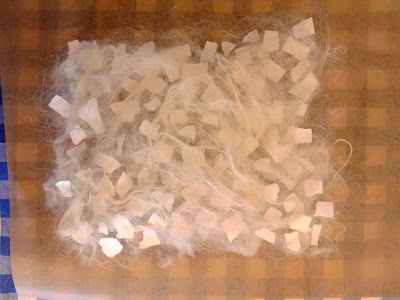In June I had taken a Zoom workshop, with artist Tunde Toth, on silk fibre papermaking (which I blogged about here) and immediately knew I planned to make more of the paper for my printmaking when taking up studio residency at Signal Arts Centre come autumn. Well, that time came fast enough and I spent the first week (plus a bit of the second week) focussed on making silk fibre paper. One of the first things for me to do, then, was set up a work station: spreading a clean table cloth over the table, having water bottle spritzer filled, iron to hand, scissors, ruler, bag of silk fibre, parchment paper roll, small dry brushes, pigments, and strips of Fabriano paper that I planned to use as inclusions.
Musings about art, writing, music, travel and food (life, the universe & everything...) by Lorraine Whelan
Wednesday, 28 October 2020
Signal studio residency: making silk fibre paper
This piece is made of a sandwich of one type of fibre with paper inclusions. It is at this stage that pigment may be sprinkled/flicked onto the fibre with a small, dry paintbrush. This is an enjoyable process, but you have to be happy to give away control, as the effects of the pigments are full of randomness (going through the processes of flicking, spritzing, and ironing to mix at their own inclination).
Cover with another sheet of parchment and gently, with the palm of your hand, rub the water into the fibres. It will be apparent what areas are wet. Turn the whole thing over and rub on the other side too, spritzing a bit more if necessary.
When finished ironing (about 5 mins) peel back the top layer carefully. If the paper still seems too wet, iron some more, but if it is mostly dry, carefully peel the whole page from the parchment.
It can finish drying on a clean piece of paper or blotting paper. This is a finished sheet of textured, undyed, silk fibre paper, with Fabriano paper inclusions. It is ready to be printed on.
Subscribe to:
Post Comments (Atom)















Hello Lorraine - what an intriguing approach to making your own paper.!! If I ever made my own paper it would be using THIS method as I couldn't physically cope with the more traditional method. I am curious if it would be possible to use this "Silk Fibre" paper for intaglio printing ? say from - for example a drypoint scratched onto polypropylene and then inked up and wiped and put through an etching press.? Polypropylene by the way its that floppy transparent plastic that is easy to cut into shapes with a scissors. aine@ainescannell.com - if you happen to know, Do you think I would be able to soak it briefly and blot it prior to printing on it through the press?. That third from last photo of the cream colour silk fibre paper looks lovely - well done you.
ReplyDeleteHi Aine, thanks for providing your email, I will send you a proper reply privately. All the best, Lorraine
Delete